Exploring Earth’s Interior with Seismic Waves
Different types of waves—light, sound, and seismic—have a common characteristic: the velocity at which they travel depends on the material through which they are passing. Light waves travel fastest through a vacuum, more slowly through air, and even more slowly through water. Sound waves, on the other hand, travel faster through water than through air and not at all through a vacuum. Why?
Sound waves are simply propagating variations in pressure. Without something to compress, such as air or water, they cannot exist. The more force it takes to compress a material, the faster sound will travel through it. The speed of sound in air—Mach 1, in the jargon of jet pilots—is typically 0.34 km/s, or about 760 miles per hour, at Earth’s surface. Water resists compression much more than air, so the speed of sound waves in water is correspondingly higher, about 1.5 km/s. Solid materials are even more resistant to compression, so sound waves travel through them at even higher speeds. Sound travels through granite at about 6 km/s—nearly 13,500 miles per hour!
Basic Types of Waves
As we saw in Chapter 13, some of the seismic waves created by earthquakes are compressional waves (like sound waves), which travel with a push-pull motion, while others are shear waves, which travel with a side-to-side motion, displacing material at right angles to their path of travel (see Figure 13.10). Solids are more resistant to compression than to shearing, so compressional waves always travel through solids faster than shear waves do. This physical principle explains a relationship we discussed in Chapter 13: compressional waves are always the first arrivals at a seismographic station (and hence are called primary, or P waves), and shear waves are the secondary arrivals (S waves). It also explains why the speed of shear waves in gases and liquids is zero: those materials have no resistance to shearing. Shear waves cannot propagate through any fluid—air, water, or the liquid iron in Earth’s outer core.
Geologists can calculate the speed of a P or S wave by dividing the distance traveled by the travel time. These wave speeds can then be used to infer which materials the waves encountered along their paths.
The concepts of travel times and wave paths sound simple enough, but complications arise when waves pass through more than one type of material. At the boundary between two different materials, some of the waves bounce off—that is, they are reflected—and others are transmitted into the second material, just as light is partly reflected and partly transmitted when it strikes a windowpane. The waves that cross the boundary between two materials are bent, or refracted, as their velocity changes from that in the first material to that in the second. Figure 14.1 shows a laser light beam whose path bends as it goes from water into air, much as a P or an S wave bends as it travels from one material to another. By studying the speeds at which seismic waves travel and how they are refracted and reflected at Earth’s internal boundaries, seismologists have been able to model the layering of Earth’s crust, mantle, and core with great precision (see Figure 1.12).
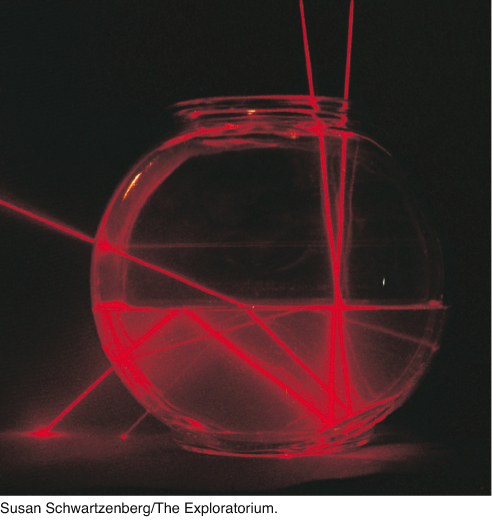
Paths of Seismic Waves Through Earth
If Earth were made of a single material with constant properties from the surface to the center, P and S waves would travel from the focus of an earthquake to a distant seismographic station along straight lines through Earth’s interior, just as the Sun’s rays travel in straight lines through outer space. When the first global networks of seismographs were installed about a century ago, however, seismologists discovered that seismic ray paths are not straight lines; the waves are refracted and reflected by Earth’s layered structure.
385
Waves Refracted Through Earth’s Interior
From their observations of travel times and the amount of upward refraction of the ray paths, seismologists were able to conclude that P waves travel much faster through rock deep within Earth than they do through rock at Earth’s surface. This was hardly surprising, because rock subjected to the great pressures in Earth’s interior would be squeezed into tighter crystal structures. The atoms in these tighter structures would be more resistant to further compression, which would cause P waves to travel through them more quickly.
Seismologists were very surprised, however, by what they found at progressively greater distances from an earthquake focus (Figure 14.2). After the P and S waves had traveled beyond about 11,600 km, they suddenly disappeared! Like airplane pilots and ship captains, seismologists prefer to measure distances traveled over Earth’s surface in angular degrees—from 0° at the earthquake focus to 180° at a point on the opposite side of Earth. Each degree measures 111 km at the surface, so 11,600 km corresponds to an angular distance of 105°, as shown in Figure 14.2. When they looked at seismograms recorded beyond 105° from the focus, they did not see the distinct P- and S-wave arrivals that were so clear on seismograms recorded at shorter distances. Beyond about 15,800 km from the focus (142°), the P waves suddenly reappeared, although they were much delayed compared with their expected travel times. The S waves never reappeared.
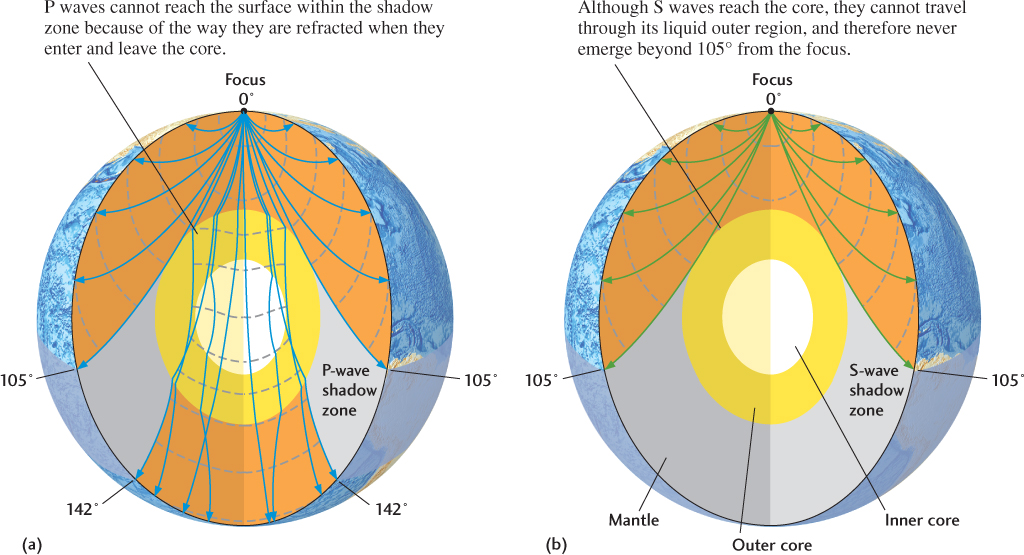
In 1906, the British seismologist R. D. Oldham put these observations together to provide the first evidence that Earth has a liquid outer core. S waves cannot travel through the outer core, he argued, because it is liquid, and liquids have no resistance to shearing. Thus, there is an S-wave shadow zone beyond 105° from the earthquake focus, where S-wave ray paths encounter the core-mantle boundary (see Figure 14.2b). The propagation of P waves is more complicated (see Figure 14.2a). At 105°, their ray paths also encounter the core-mantle boundary. At that boundary, P-wave velocity drops by almost a factor of two. Therefore, the waves are refracted downward into the core and emerge at greater angular distances after the delay caused by their detour through the core. This refraction effect forms a P-wave shadow zone at angular distances between 105° and 142°.
386
Waves Reflected By Earth’s Internal Boundaries
When seismologists looked at records of seismic waves made at angular distances of less than 105° from an earthquake focus, they found waves that must have been reflected from the core-mantle boundary. They labeled a compressional wave reflected from the top of the outer core PcP and a shear wave ScS. (The lowercase c indicates a core reflection.) In 1914, a German seismologist, Beno Gutenberg, used the travel times of these reflected waves to determine the depth of the core-mantle boundary, which modern estimates put at about 2890 km. Figure 14.3 shows examples of the ray paths taken by these core-reflected waves.
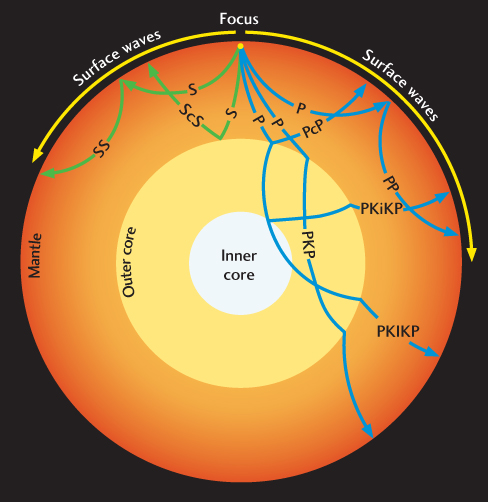
Figure 14.3 also shows the ray paths of some other prominent wave types seen on seismograms, along with the labels seismologists have attached to them. For example, a compressional wave reflected once at Earth’s surface is labeled PP, and a shear wave with a similar path is labeled SS. Figure 14.4 shows the ray paths of these wave types and their internal reflections on seismograms recorded at different angular distances from an earthquake focus.
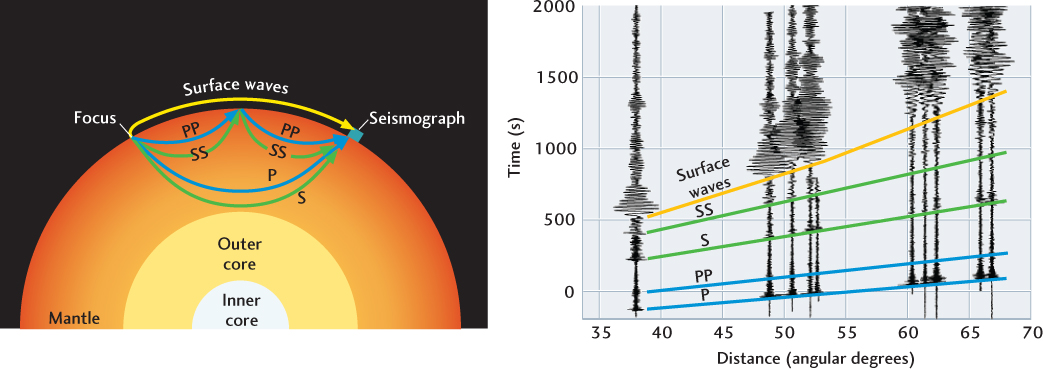
The ray path of a compressional wave through the outer core is labeled with a K (from the German word for “core”), so PKP designates a compressional wave that propagates through the crust and mantle, into the outer core, and back through the mantle and crust to a seismograph at Earth’s surface. In 1936, Danish seismologist Inge Lehmann (Figure 14.5) discovered Earth’s inner core by observing compressional waves refracted by its outer boundary, which she determined to be at a depth of about 5150 km. Ray paths through the inner core are labeled with an I, so the waves Lehmann observed are labeled PKIKP. Other seismologists have since observed compressional waves (labeled PKiKP) reflected from the top side of the inner core–outer core boundary (the lowercase i indicates a reflection rather than a refraction; see Figure 14.3).
387

Seismic Exploration of Near-Surface Layering
Seismic waves can also be used to probe the shallow parts of Earth’s crust. This technique, called seismic profiling, has a number of practical applications. Seismic waves generated by artificial sources, such as dynamite explosions on land and compressed-air explosions at sea, are reflected by geologic structures at shallow depths in the crust (Figure 14.6). Recording of these reflections has proved to be the most successful method for finding deeply buried oil and gas reservoirs. This type of seismic exploration is now a multibillion-dollar industry. Reflected seismic waves are also used to measure the depth of water tables and the thickness of glaciers. At sea, compressional waves can be generated by mechanical devices similar to loudspeakers, and oceanographic ships routinely use the underwater sound they produce to measure the depth of the ocean and the thickness of sediments on the seafloor.
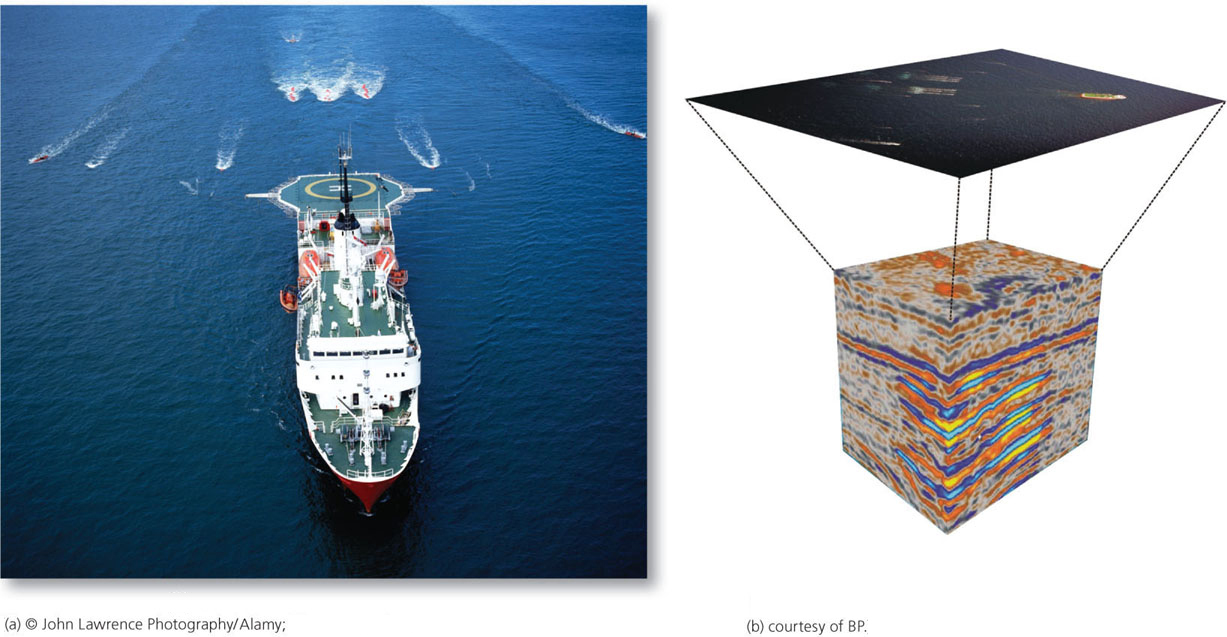
388